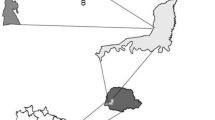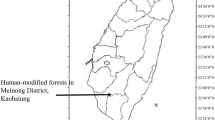Abstract
In this study we compare the richness, abundance and guild composition between two different reforestations in the meridional part of the Amazon. We test the hypothesis that the termite community is affected by the identity of the tree species used in reforestation. More precisely, we test whether the reforestation of a native species of fig (Ficus sp) is more efficient in restoring biodiversity than reforestation of exotic teak trees (Tectona grandis). We sampled the termite community in these reforested areas and three other different “control” areas: active pastures, abandoned pastures (secondary forests) and mature pristine forest. We found that the distance of reforestation from the nearest primary forest had no effect on termite biodiversity, at the scale studied. But, as expected, richness and the abundance were higher in the mature forest, intermediate in reforestation areas, and lower in secondary forest and pastures. In fact, the only studied habitat with biodiversity comparable to the mature forest was the fig plantations. The guild composition in reforested areas was also similar to that of the mature forest. The diversity and abundance of humivorous termites was particularly pronounced in the reforestation areas compared with pasture or secondary forests. The humivorous guild provides important functional services, since its action makes nitrogen and other nutrients available to the plants along ecological succession. Our results show that reforestation is a valuable strategy in restoring termite diversity and recovering the ecosystem services they provide.



Similar content being viewed by others
References
Abe T (1987) Evolution of life types in termites. Kawano S, Connel JH e Hidaka T (1987) Evolution and Coadaptation in Biotic Communities. University of Tokyo Press, Tokyo, pp 126–148
Ackerman IL, Constantino R, Gauch HG, Lehmann J, Riha SJ, Fernandes ECM (2009) Termite (Insecta : Isoptera) Species composition in a primary rain forest and agroforests in Central Amazonia. Biotropica 41:226–233
Aerts R, Honnay O (2011) Forest restoration, biodiversity and ecosystem functioning. BMC Ecol 11:29
Attignon SE, Lachat T, Sinsin B, Nagel P, Peveling R (2005) Termite assemblages in a West-African semi-deciduous forest and teak plantations. Agric Ecosyst Environ 110:318–326
Audino LD, Louzada J, Comita L (2014) Dung beetles as indicators of tropical forest restoration success: Is it possible to recover species and functional diversity? Biol Conserv 169:248–257
Balesdent J, Chenu C, Balabane B (2000) Relationship of soil organic matter dynamics to physical protection and tillage. Soil Till Res 53:215–230
Bhavana KV, Poovoli A, Rajmohana K (2015) A comparison on termite assemblages in coffee & teak plantations and semi-evergreen forest—a case study in North Wayanad, Kerala, India. Trop Agric Res 26(3):456–467
Bignell DE, Eggleton P (2000) Termites in ecosystems. In: Abe T, Bignell DE, Higashi M (eds) Termites: evolution, sociality, symbioses, ecology. Kluwer Academic Publishers, Dordrecht, pp 363–387
Bihn JH, Gebauer G, Brandl R (2010) Loss of functional diversity of ant assemblages in secondary tropical forests. Ecology 91:782–792
Cadotte MW, Carscaddem K, Mirotchnick N (2011) Beyond Species: functional diversity and the maintenance of ecological processes and services. J Appl Ecol 48:1079–1087
Carrijo TF, Brandão D, Oliveira DE, Costa DA, Santos T (2009) Effects of pasture implantation on the termite (Isoptera) fauna in the central Brasillian Savanna (Cerrado). J Insect Conserv 13:575–581
Chapin FS, Zavaleta ES et al (2000) Consequences of changing biodiversity. Nature 405:234–242
Constantino R (2005) Padrões de diversidade e endemismo de térmitas no bioma Cerrado. In: Scariot et al. (eds) Biodiversidade, ecologia e conservação do Cerrado. Ministério do Meio Ambiente, Brasília, pp 319–333
Cunha EF, Orlando TYS (2011) Functional composition of termite species in areas of abandonated pasture and in secondary sucession of the Parque Estadual Altamiro de Moura Pacheco, Goiás, Brasil. Biosci J 27:986–992
Diaz S, Cabido M (2001) Vive la difference: plant functional diversity matters to ecosystem processes. Trends Ecol Evol 16:646–655
Donovan SE, Jones DT, Sands W, Eggleton P (2000) Morphological phylogenetics of termites (Isoptera). Biol J Linn Soc 70:467–513
Donovan SE, Griffiths GJK, Homathevi R, Winder L (2007) The spatial pattern of soil-dwelling termites in primary and logged forest in Sabah, Malaysia. Ecol Entomol 32:1–10
Ehrlich PR, Ehrlich AH (1981) Extinction: the causes and consequences of the disappearance of species. Random House, New York
Healey SP, Gara SI (2003) The effect of a teak (Tectona grandis) plantation on the establishment of native species in an abandoned pasture in Costa Rica. For Ecol Manag 176(1–3):497–507
Higashi M, Abe T, Burns TP (1992) Carbon–nitrogen balance and termite ecology. Proc R Soc Lond B Biol Sci 249:303–308
Hölldobler B and Wilson EO (1990) The Ants. Cambridge, USA
Hooper DU, Chapin FS et al (2005) Effects of biodiversity on ecosystem functioning: a consensus of current knowledge. Ecol Monogr 75:3–35
Ji J, Kappler A, Brune A (2000) Transformation and mineralization of synthetic 14C-labeled humic model compounds by soil-feeding termites. Soil Biol Biochem 32:1281–1291
Jones DT, Eggleton P (2000) Sampling termite assemblages in tropical forests: testing a rapid biodiversity assessment protocol. J Appl Ecol 37:191–203
Jouquet P, Traoré S, Choosai C, Hartmann C, Bignell D (2011) Influence of termites on ecosystem functioning. Ecosystem services provided by termites. Eur J Soil Biol 47:215–222
Jouquet P, Blanchart E, Capowiezc Y (2014) Utilization of earthworms and termites for the restoration of ecosystem functioning. Appl Soil Ecol 73:34–40
Kappler A, Ji R, Brune A (2000) Synthesis and characterization of specifically 14C-labeled humic model compounds for feeding trials with soil-feeding termites. Soil Biol Biochem 32:1271–1280
Kottek M, Grieser J, Beck C, Rudolf B, Rubel F (2006) World map of the Köppen-Geiger climate classification updated. Meteorol Zeit 15:259–263
Lal R (2015) Restoring soil quality to mitigate soil degradation. Sustainability 7:5875–5895
Lima JT, Costa-Leonardo AM (2007) Recursos alimentares explorados pelos cupins (Insecta: Isoptera). Biota Neotr 7:243–250
Martius C, Höfer H, Garcia MVB, Römbke J, Förster B, Hanagarth W (2004) Microclimate in agroforestry systems in central Amazonia: does canopy closure matter to soil organisms? Agrofor Syst 60:291–304
Miyashita T, Amano T, Yamakita T (2014) Effects of ecosystem diversity on species richness and ecosystem functioning and services: a general conceptualization. In: Nakano S, Yahara T, Nakashizuka T (eds) Integrative observations and assessments. Springer, Tokyo, pp 29–47
Moulton TP (2013) Funcionamento de ecossistema e a interface com a comunidade ecológica In: Nogueira FCB et al (eds) A Teoria ecológica: perspectivas e avanços futuros nos últimos dez anos de pesquisa no Brasil. Fortaleza-CE, pp 77–93
Petchey OL, Gaston KJ (2002) Functional diversity (FD), species richness and community composition. Ecol Lett 5:402–411
Reis YT, Cancello EM (2007) Riqueza de cupins (Insecta, Isoptera) em áreas de Mata Atlântica primária e secundária do sudeste da Bahia. Inheringia Ser Zool 97:229–234
Ren H, Li Z, Shen W, Yu Z, Peng S, Liao C, Ding M, Wu J (2007) Changes in biodiversity and ecosystem function during the restoration of a tropical forest in south China. Sci China Ser C 50(2):277–284
Tewari DN (1992) A monograph on bamboo. International Book Distributors, India
Vasconcellos A, Bandeira AG, Moura FMS, Araújo VFP, Gusmão MAB, Constantino R (2010) Termite assemblages in three habitats under different disturbance regimes in the semi-arida Caatinga of NE Brazil. J Arid Environ 74:298–302
Wilkinson L (2010) SYSTAT. WIREs. Comp Stat 2:256–257
Acknowledgments
We are grateful to Victor Landeiro and Jerry M Penha for their helpful comments in early versions of this manuscript. We thank São Nicolau farm administrators and staff and the Carbon sink project (Pegeout propriety, managed by ONF—Office National des Fôrets) for their logistical and financial support. RMP and TJI are grateful to CAPES—Coordenação de aperfeiçoamento de Pessoal de Nível Superior (TJI proccess BEX 2548/14-3 and 479243/2012-3).
Author information
Authors and Affiliations
Corresponding author
Rights and permissions
About this article
Cite this article
de Paula, R.C., de Moraes Lima Silveira, R., da Rocha, M.M. et al. The restoration of termite diversity in different reforestated forests. Agroforest Syst 90, 395–404 (2016). https://doi.org/10.1007/s10457-015-9862-2
Received:
Accepted:
Published:
Issue Date:
DOI: https://doi.org/10.1007/s10457-015-9862-2




